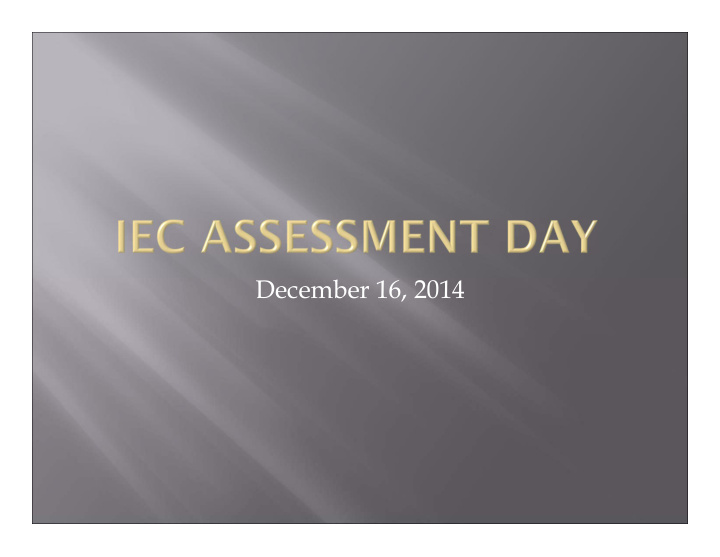



December 16, 2014
9:30 a.m. Welcome & Approval of Minutes from November 20, 2014 9:35 a.m. Reports Assessment Subcommittee General Education University Learning Outcomes 10:00 a.m. Set Meeting Schedule for Spring 2014 10: 15 a.m. Break 10:30 a.m. NSSE Results and Discussion Noon Lunch 12:30 p.m. Results from Preliminary Strategic Planning Survey
IEC Assessment Subcommittee General Education University Learning Otucomes
Review of Academic Programs shows that the majority of units are either best practice or acceptable overall Outcomes is the area of greatest strength. Use of results is an area of relative weakness.
Additional Conclusions All units have established measurement targets for their program outcomes. Some units have established program outcomes in addition to program learning outcomes. Going Forward All units will need to establish program outcomes in addition to program learning outcomes. Director of IEP will produce a report on first three years of reviewing for February meeting of IEC. To Academic Units: keep up the good work!
Areas Assessed 2013-14 Area B: Institutional Options Area D: Natural and Computational Sciences Global Perspectives Areas to Be Assessed 2014-15 (again) Area A1 Area A2 Critical Thinking
Area B Learning Outcome 1: Students will be able to evaluate information critically. Targeted Course LIBR 1101 Information Literacy Area B Learning Outcome 2: Students will be able to understand cultural differences. Targeted Courses THEA 1110 Performance Skills for Business and Professions WMST 2001 Introduction to Women’s Studies
Outcome 1 Outcome 2 Assessment of Class Assessment of Class Projects (N=79) Projects in LIBR 1101 (N=72) 80% of the students able to recognize their own 93% of the students cultural assumptions and sampled were able to use biases at least adequately information to achieve a purpose at or above the 57% of students able to meets adequately level recognize elements that are important to members 87% were able to evaluate of another culture at least information critically at or adequately above the meets adequately level Target=80% Target=85%
Area D Learning Outcomes Students will be able to interpret symbolic representations of data relevant to the physical world Students will be able to evaluate the relationship between observation and inference in the natural sciences Targeted Courses A variety of courses in Biology, Chemistry, Geology, and Physics
Embedded Assessment Questions on Final Exams (different questions in each class/unit) 1) the student can determine a critical value from a symbolic representation of a set of values (interpret) 2) the student can provide a qualitative description of the relationship between two parameters presented in a symbolic representation of data (relationships) 3) Based on the relationship(s) depicted in the graphic representation, the student can predict or extrapolate a value that is not given or can assess the generality or consistency of their prediction (predict)
Biology Interpret=81.7% Relationships=86.9% Targets Predict=60.7% Interpretation Chemistry Target=70% Interpret=95.6% Relationships=70% Relationships=74.3% Prediction Predict=78.4% Target=70% Geology-Physics Interpret=74% Relationships=66.7% Predict=54%
Global Perspectives Learning Outcome: Students will be able to articulate factual and conceptual knowledge concerning world-wide societal dynamics. Targeted Courses HIST 1111 World Civilization I HIST 1112 World Civilization II
Embedded Assessment Question on Final Exam History faculty assessed on questions using a rubric with one element and five levels of achievement (five highest to one lowest) Target=85% at 3 or above Results 5=13.4% 4=19.4% 3=23.9% 2=17.9% 1=25.4%
Area B Outcome 2 slightly below target Area D Comparability of results Presentation of results Several areas where results are significantly below target Global Perspectives Results significantly below target, especially high percentage of ones.
Any suggestions for improvement? Overall report on first three years of attainment plan forthcoming.
GSW Graduates have demonstrated general competency in the following areas: Written Communication Quantitative Problem Solving Critical Evaluation of Information Understanding of Cultural Differences Articulating Factual and Conceptual Knowledge of the Humanities and Fine Arts Interpreting Symbolic Representations of Data Relevant to the Physical World Evaluating the Relationship between Observation and Inference in the Natural Sciences
GSW Graduates have demonstrated general competency in the following areas (continued): Articulating Factual and Conceptual Knowledge Concerning historical and societal dynamics within the US Concerning world-wide historical and societal dynamics Evaluating Problems or Texts Composing Organized, Coherent, and Accurate Responses to Problems or Texts
GSW Graduates have demonstrated advanced competency in at least one area of Specialized Learning (the Major) GSW Graduates have demonstrated competency appropriate to their area of specialized learning in the following Intellectual Skills: Communication Quantitative Reasoning Problem Solving Information Literacy
GSW Graduates are able to apply their Specialized Learning and their Intellectual skills in real world situations GSW Graduates have demonstrated general competency in the following areas of Global Learning: Identifying, describing and explaining cultural differences Asking questions about other cultures and finding answers to those questions Interacting with people from other cultures
What needs to be done? How many meetings will be necessary to accomplish these tasks?
Link to NSSE Results Package
6308 Email invitation sent to Students, Fac- Staff, and GSW Foundation Trustees Note that about 20% of emails bounced, so only about 5000 emails were actually received 1389 (22%) opened the email 492 (35%) started the survey 366 (74%) completed the survey 234 Students 101 Fac-Staff (58/43) 11 Administrators 8 Trustees
Top Three Strengths Academic Programs (238) Faculty-Student Interaction (231) Learning Environment (183) Top Three Weaknesses Financial Resources (144) Tie Campus Atmosphere (89) Campus Facilities (89) Administration (88)
Selected Opportunities (multiples) Community involvement-economic development Consolidation-Merger New president-administration More online opportunities Selected Challenges (multiples) Consolidation-Merger Faculty turnover-compensation Lack of student activities-retention Enrollment Finances
Recommend
More recommend